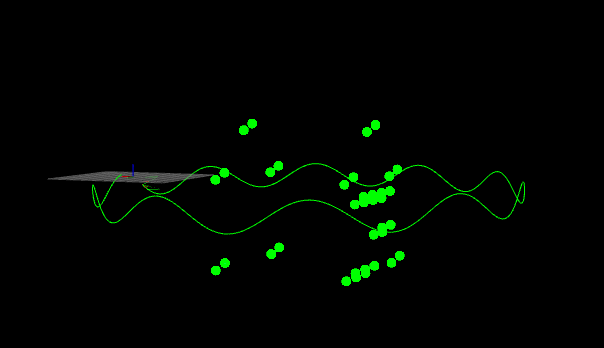SLAM: 用测试数据集来测试VINS
目前编写双目VINS代码,发现双目VINS初始化后的尺度存在问题(理想化双目尺度应该为1),所以想着利用无误差的测试集来测试一下自己写的代码。我先在单目VINS下做了测试,下面是我利用github上贺所长的单目测试集在单目vins上测试的过程:
1.单目VINS测试数据集:https://github.com/HeYijia/vio_data_simulation.
(下载后通过mkdir build;cd build; cmake ..; make ; cd ../bin; ./data_gen 命令生成待读取数据,数据存储在bin/里面)
(1)gener_alldata.cpp :
A. createpointslines(): 通过这个函数取出设计好的房子图形中的map点,之后所有的图像都能观测到这些map点,且顺 序不变;
B. imudata 和 imudata_noise: 只用了imudata;
C. camdata: 完全由imudata 和map点决定,所以没有误差;
(2)imudata的生成:imu.cpp
A. MotionModel: 直接给出imu的线加速度和角加速度 以及imu的R、t;(需要推导)
2.在VINS中新建两个节点分别读取feature数据 和 imu数据:
(1)其中map点在各帧观测的归一化坐标存储在 vio_data_simulation/bin/keyframe/all_points_x.txt中
(6维,map3维+1+归一化坐标点2维),
(2)feature的时间 存储在vio_data_simulation/bin/cam_pose.txt中
(14维,时间1维+q4维+t3维+陀螺仪加速度3维+线加速度3 维),
(3)imu数据存储在vio_data_simulation/bin/imu_pose.txt(无噪声)
( 与cam_pose存储相同,只需要时间和gyro、acc 7维)。
3.节点发布:
(1)feature发布:注意频率为30
ros::init(argc, argv, "test_pub_feature");
ros::NodeHandle n("~");
ros::console::set_logger_level(ROSCONSOLE_DEFAULT_NAME, ros::console::levels::Info);
pub_img = n.advertise("feature", 1000);
test_s();// 读取feature 和 time 数据
int count = 0;
ros::Rate loop_rate(30);
while(ros::ok())
{
pub_feature(all_points[count],cam_time[count]);
ros::spinOnce();
loop_rate.sleep();
count ++;
} (2)imu发布:注意频率为200(与上面类似)
4.参数修改:projection_parameters + cam to imu 的 R、t
5.运行结果:refine之前g=9.80418
6.完整代码:
test_pub_feature.cpp
#include
#include
#include
#include
#include
#include
#include
#include
#include
#include
bool PUBLISH = 1;
ros::Publisher pub_img,pub_match,pub_imu;
ros::Publisher pub_restart;
int image_num = 600;
int init_pub = 0;
/*
struct Imu_Data
{
double time;
Eigen::Vector3d angular_velocity;
Eigen::Vector3d linear_acceleration;
};*/
void Load_Feature(std::string filename, std::vector &point)
{
std::ifstream f;
Eigen::Vector3d pw;
Eigen::Vector2d pts;
f.open(filename.c_str());
if(!f.is_open())
{
std::cerr << " can't open LoadFeatures file "<>pw(0);
ss>>pw(1);
ss>>pw(2);
ss>>empty;
ss>>pts(0);
ss>>pts(1);
point.push_back(pts);
}
}
}
void Load_camTime(std::string filename, std::vector &time)
{
std::ifstream f;
double per_time;
f.open(filename.c_str());
if(!f.is_open())
{
std::cerr << " can't open LoadcamTime file "<>per_time;
ss>>q.w();
ss>>q.x();
ss>>q.y();
ss>>q.z();
ss>>t(0);
ss>>t(1);
ss>>t(2);
ss>>gyro(0);
ss>>gyro(1);
ss>>gyro(2);
ss>>acc(0);
ss>>acc(1);
ss>>acc(2);
time.push_back(per_time);
}
}
}
void pub_feature(const std::vector &point, const double per_time)
{
sensor_msgs::PointCloudPtr feature_points(new sensor_msgs::PointCloud);
sensor_msgs::ChannelFloat32 id_of_point;
sensor_msgs::ChannelFloat32 u_of_point;
sensor_msgs::ChannelFloat32 v_of_point;
sensor_msgs::ChannelFloat32 velocity_x_of_point;
sensor_msgs::ChannelFloat32 velocity_y_of_point;
ros::Time feature_time(per_time);
feature_points->header.stamp = feature_time;
feature_points->header.frame_id = "world";
for(int i=0; ipoints.push_back(p);
id_of_point.values.push_back(i);
u_of_point.values.push_back(0);
v_of_point.values.push_back(0);
velocity_x_of_point.values.push_back(0);
velocity_y_of_point.values.push_back(0);
}
feature_points->channels.push_back(id_of_point);
feature_points->channels.push_back(u_of_point);
feature_points->channels.push_back(v_of_point);
feature_points->channels.push_back(velocity_x_of_point);
feature_points->channels.push_back(velocity_y_of_point);
//ROS_INFO("publish Point %f, at %f", feature_points->header.stamp.toSec(), ros::Time::now().toSec());
pub_img.publish(feature_points);
}
std::vector cam_time;
std::vector> all_points;
void test_s()
{
std::stringstream filename_camTime;
filename_camTime<<"/home/lupingping/slam/catkin_ws/src/data_for_test/vio_data_simulation/bin/cam_pose.txt";
Load_camTime(filename_camTime.str(), cam_time);
for(int n = 0; n < image_num; n++)
{
std::stringstream filename_feature;
filename_feature<<"/home/lupingping/slam/catkin_ws/src/data_for_test/vio_data_simulation/bin/keyframe/all_points_"<< n <<".txt";
std::vector point;
Load_Feature(filename_feature.str(), point);
all_points.push_back(point);
}
}
int main(int argc, char **argv)
{
ros::init(argc, argv, "test_pub_feature");
ros::NodeHandle n("~");
ros::console::set_logger_level(ROSCONSOLE_DEFAULT_NAME, ros::console::levels::Info);
pub_img = n.advertise("feature", 1000);
test_s();
int count = 0;
ros::Rate loop_rate(30);
while(ros::ok())
{
pub_feature(all_points[count],cam_time[count]);
ros::spinOnce();
loop_rate.sleep();
count ++;
}
} test_pub_imu.cpp
#include
#include
#include
#include
#include
#include
#include
#include
#include
#include
#include
bool PUBLISH = 1;
ros::Publisher pub_imu;
struct Imu_Data
{
double time;
Eigen::Vector3d angular_velocity;
Eigen::Vector3d linear_acceleration;
};
void Load_imu(std::string filename, std::vector &imu_data)
{
Imu_Data imu_temp;
std::ifstream f;
f.open(filename.c_str());
if(!f.is_open())
{
std::cerr << " can't open Loadimu file "<>time;
ss>>q.w();
ss>>q.x();
ss>>q.y();
ss>>q.z();
ss>>t(0);
ss>>t(1);
ss>>t(2);
ss>>gyro(0);
ss>>gyro(1);
ss>>gyro(2);
ss>>acc(0);
ss>>acc(1);
ss>>acc(2);
imu_temp.time = time;
imu_temp.linear_acceleration = acc;
imu_temp.angular_velocity = gyro;
imu_data.push_back(imu_temp);
}
}
}
void pubImu(const Imu_Data & imu_data)
{
sensor_msgs::ImuPtr imu(new sensor_msgs::Imu);
geometry_msgs::Vector3 linear_acceleration;
geometry_msgs::Vector3 angular_velocity;
ros::Time imu_time(imu_data.time);
imu->header.stamp = imu_time;
linear_acceleration.x = imu_data.linear_acceleration(0);
linear_acceleration.y = imu_data.linear_acceleration(1);
linear_acceleration.z = imu_data.linear_acceleration(2);
imu->linear_acceleration = linear_acceleration;
angular_velocity.x = imu_data.angular_velocity(0);
angular_velocity.y = imu_data.angular_velocity(1);
angular_velocity.z = imu_data.angular_velocity(2);
imu->angular_velocity = angular_velocity;
pub_imu.publish(imu);
}
std::vector cam_time;
std::vector imu_data;
std::vector> all_points;
void test_s()
{
std::stringstream filename_imu;
filename_imu << "/home/lupingping/slam/catkin_ws/src/data_for_test/vio_data_simulation/bin/imu_pose.txt";
Load_imu(filename_imu.str(),imu_data);
}
int main(int argc, char **argv)
{
ros::init(argc, argv, "test_pub_imu");
ros::NodeHandle n("~");
ros::console::set_logger_level(ROSCONSOLE_DEFAULT_NAME, ros::console::levels::Info);
pub_imu = n.advertise("imu",1000);
test_s();
int count = 0;
ros::Rate loop_rate(200);
while(ros::ok())
{
pubImu(imu_data[count]);
ros::spinOnce();
loop_rate.sleep();
count ++;
}
} 
